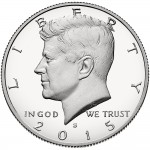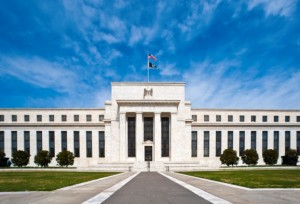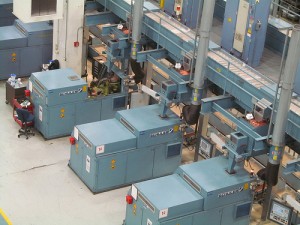Weekly World Numismatic News for April 11, 2021
Some can make an argument to call the Farouk-Fenton 1933 Saint-Gaudens Gold $20 Double Eagle coin the most famous coin in the world. Although other coins have surpassed it in price since Stuart Weitzman purchased it in 2002, its legend lives beyond any other coin.
The story of the coin spans families, generations, continents, court cases, and was almost destroyed in the World Trade Center on September 11, 2001. Its story was told in two excellent books and the revealing of the coin’s current owner made international headlines.
Now, the world’s most famous coin has been certified, graded, but not entombed in plastic. Sotheby’s requested the grading and certification for the coin and asked that the coin not be slabbed. PCGS graded the coin and provided an image certification. They also announced that the new owner could submit the coin for holdering after the auction.
Although certification is necessary for some coins in this day of counterfeits, there are some coins whose importance goes beyond the need to entomb them in plastic away from the world. The last legal tender gold coin from the time Franklin D. Roosevelt withdrew gold from the market is one of those coins.
There have been other famous coins displayed in slabs that give them a lonely feel. Looking at any of the five 1913 Liberty Head Nickels makes it seem like it’s trapped instead of proudly standing, showing off its fascinating story. The same fate awaits the 1933 Double Eagle should its next owner decide the plastic is more important than the coin.
For the sake of allowing the legend to live, I hope the next owner decides not to hide this coin in plastic and allows the world to celebrate its story and beauty.
And now the news…
 → Read more at nytimes.com
→ Read more at nytimes.com
 → Read more at news.artnet.com
→ Read more at news.artnet.com
 → Read more at livescience.com
→ Read more at livescience.com
 → Read more at syfy.com
→ Read more at syfy.com
More words
![]() Since having the Numismatic Dictionary active for over a month, the reception has been more than my expectations!
Since having the Numismatic Dictionary active for over a month, the reception has been more than my expectations!
According to the server statistics, there have been over 500 unique visitors to that page with more 20-percent returning for another look. Since I put a bit of work into that database, it is nice to see it is being used.
I also received feedback with corrections and requests for additions. Corrections are wonderful and encouraged. If you see something wrong, send me a note and I will make the correction.
As for the additions, I received a request for 12 additional terms. As I was researching some of the terms to ensure I entered the right information, I found a few more to add. I had to stop at adding 51 additional terms. Some of the new additions include banknote, bit, branch mint, coin orientation, crown, encased postage stamps, euro, farthing, intaglio, legal tender, manganese, medal orientation, pet crime, pound, real, shilling, small dollar, and third-party grading service.
I really appreciate all of the input and hope it helps the numismatic community!
Keys and Mints Reference
 Recently, I was notified that the company whose notebook-like program decided to close its virtual doors. Its concept was simple: act like a notebook that you can stuff anything into. Although other programs passed it in some features, it was still a solid way of keeping a digital notebook. Now that they are out of business, I do not want to rely on what we call “abandonware.”
Recently, I was notified that the company whose notebook-like program decided to close its virtual doors. Its concept was simple: act like a notebook that you can stuff anything into. Although other programs passed it in some features, it was still a solid way of keeping a digital notebook. Now that they are out of business, I do not want to rely on what we call “abandonware.”
As I was reviewing a few of the notebooks I created, I found now with a lot of numismatic notes. This notebook contains lists, ideas, and other items of numismatic information. Rather than keep them hidden from the public on my disk, I will start to publish what I find as part of my Collector’s Reference section.
Today begins with two additions:
- Key Date Coins is a list of coins that may be considered key dates for their series. Determining key date coins sometimes is a matter of opinion, especially on older series. My notes had several lists which I used a basic polling system, mintage statistics, and third-party grading company’s population reports to determine what to add. This list only does this for non-gold coins. I will try to find similar references for gold coins and add them in the future.
- Mints and Mintmarks documents every branch mint operated by the U.S. Mint and provides a little information paragraph about them including the branch mint in Manila while the Philippines was a colony of the United States.
I hope you find this helpful. As always, you can always send me additions or corrections. Other comments are welcome below.
History for a half-dollar
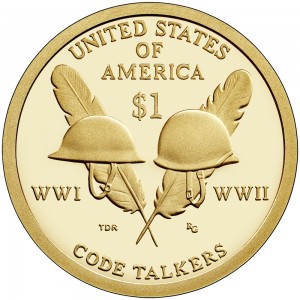
2016 Native American Dollar celebrates the contributions of the Native American Code Talkers in World War I and World War II
The reverse designs has represented some of the best work by the artists working with the U.S. Mint with the 2016 design continuing the record. Celebrating the Native American Code Talkers who were instrumental in using their native language to communicate troop movements and enemy positions, the reverse of the coin celebrates their work.
As someone who has made a career in technology and information security, the concept of using something as low-tech as a language that nobody else can translate to openly communicate secret information is an elegant solution. It proves that technology is an answer but not the only answer. It makes these people heroes for their service to a country that has not treated their people fairly over the course of history.
Learning and honoring the history of Native Americans was the goal of the Native American $1 Coin Act. It is a simple yet effective way to bring history to the masses. Although the dollar coin does not circulate well, it is still a nice way for the country to teach and honor history.
I was thinking about what could be done to honor other aspects of United States history. Why not use another coin to celebrate something that has shaped the country in some way. With over 200 years of history, there is a lot to choose from. I propose that beginning in 2017 the reverse of the Kennedy half-dollar be changed every year to celebrate an anniversary of something significant in U.S. history.As I consider writing a draft version of the bill to send to my representatives in congress, I know that any good coinage program in the United States should have some guidelines. Far be it for congress to tell the U.S. Mint to do what it thinks is right. In order to satisfy something that congress would adopt and create a meaningful program, how about a Half-Dollar history program as follows:
- The obverse will remain unchanged, the edge will continue to be reeded, and the coin will remain a half-dollar
- Reverse design changes annually and only one design per year
- Half-dollar can be made for circulation and the U.S. Mint can create collector versions including silver collectibles and different finishes
- Theme for the reverse must be from 50 years prior to the year of circulation and older with anniversary dates being divisible by 25 (i.e., 50 years ago, 75, 100, 125, 150, etc.)
- Theme will be selected by the U.S. Mint in collaboration with the CCAC and the Smithsonian Institute National Museum of American History
- The U.S. Mint creates the design for the theme selected by either using in-house artists, AIP members, or may hold an open competition
- The CCAC will review the designs
- The program will have no end date
Although there was no such thing as having a minor when I went to college, I did use some of my elective credits to take some classes in history and political science. Add my masters in public policy and some people wonder why I don’t run for office (I hate the idea of begging for campaign contributions). With that background, I was able to think of a few historical events that could be honored over the next few years:
Purposely missing from this list is the 75th anniversary of Jackie Robinson’s becoming the first African-American to appear in a Major League Baseball game in 1947. I fully expect that a commemorative coin will be issued for that event. If it is not, then congress should be ashamed of itself for not doing so.
From ordering to circulation
The process begins when the Federal Reserve places their annual order with the U.S. Mint for coins and the Bureau of Engraving and Printing for currency. Like any organization that deals with inventory, the Federal Reserve will estimate its order based on a projection of demand.
Inventory management for the Federal Reserve requires them to know how much currency is in circulation, how much will be required based on world-wide economic factors, and what would be required to replace the current currency supply. Since the Federal Reserve ships U.S. currency world wide, especially the $100 Federal Reserve Notes, someone has to project what the world is going to demand based on economic factors that it has no participation in.
| Denomination of Bill | Life Expectancy (Years) |
|---|---|
| $ 1 | 5.9 |
| $ 5 | 4.9 |
| $10 | 4.2 |
| $20 | 7.7 |
| $50 | 3.7 |
| $100 | 15 |
Not only does the Federal Reserve has to track the amount of money in circulation but they also have to account for the different denominations in order to replace torn and worn notes. For instance, it was once estimated that 90-percent of the order for $1 Federal Reserve Notes were delivered to replace worn notes in circulation.
Once the order is placed by the Federal Reserve, the U.S. Mint and the Bureau of Engraving and Printing work to fulfill that order. The U.S. Mint strikes the coins and has they placed in one-ton ballistic bags for delivery. The Bureau of Engraving and Printing bundles the currency in packs. Multiple packs make a brick. Bricks are then piled on pallets that are used for delivery.
From Philadelphia and Denver, the coin bags are loaded onto secured trucks and transferred to the Federal Reserve for distribution. A similar transfer happens at the Bureau of Engraving and Printing in Washington and Fort Worth where the pallets are shipped to the Federal Reserve.
Although there may be a few warehouses and other distribution processes involved, the coins and currency are shipped to one of 26 “cash rooms” around the country based on need. These cash rooms are special warehouses operated by the Federal Reserve branch that store the physical currency before being distributed to the member banks.
Since the New York Federal Reserve Bank processes currency orders for overseas shipping, they order the most currency of the 12 regional banks. San Francisco provides banking services for Alaska, Hawaii, and other transactions throughout the Pacific Rim, orders the second most amount of currency.Before currency can enter circulation, a member bank places an order with the Federal Reserve. It is then delivered to them from the closest cash room with the appropriate inventory necessary to fulfill the order.
Your personal bank is like the corner store in the ordering system. When the shelves are bare or threatening to go bare, they order the inventory of currency they need. The corner bank just do not order money from the Federal Reserve. Banking companies work on behalf of their branches to manage inventory. The big bank may have their own cash management operations that help ensure that they not only have the appropriate amount of currency available but they do not have too much in storage. Like product inventories, idle money is not good for business.
Many banks hire logistics companies to help with the flow of their currency inventory. These companies are the ones driving the armored trucks you see around town that delivers currency on order. While these logistic companies are registered currency distribution services and have permits to pick up inventory from the Federal Reserve cash rooms on behalf of the member banks, they also provide storage and delivery services.
Although your corner bank has a vault, each banking company limits the amount of currency they keep on site because of security concerns. When they need additional currency or have an excess that needs to be stored, they call the logistics company to physically move the inventory.
These logistics company do not take the currency and put it on the shelf until the bank calls back and asks for it to be returned. If a bank deposits a bag of quarters with the logistics company but another bank asks for bags of quarters, that bag could be transferred to another bank. Banks may order currency from the Federal Reserve or smaller banks from other cooperating banks, the logistics companies fulfill the orders from existing stock before accessing new stock.Depending on how fast the currency is needed to circulate by your corner bank, existing currency can circulate through the logistics processing center long before the new inventory is placed into circulation.
During the recent downturn in the economy, the banks’ inventories of coins increased as people emptied jars, jugs, and bottles of coins for necessities. As the coins were returned to the bank the inventories rose beyond what they needed for circulation reducing the requirement for the banks to order more coins from the Federal Reserve. This is why it was not surprising that many people did not see current year coins until as early as April.
It is more difficult to gauge when currency reaches circulation unless there is a change in the series designation. The Series of a note is the date followed by a letter indicating that there is a change, usually to the autograph of the Treasurer or the Secretary of the Treasury. Although there is no rule, the Series date changes with an administration and the letter is added and changes as the autographs changes. Sometimes, the series date changes with the design of the currency. These are recent conventions and not the rule. All printing and design decisions are made by the Federal Reserve, Bureau of Engraving and Printing, and the U.S. Secret Service as a team.
If you want to know when the 2016 coins will reach circulation, the answer is “I don’t know.” Considering the economy is in better shape than in years past, money continues to circulate, and the U.S. Mint has produced more coins in a single year than any other in its history, if you have not seen a 2016 coin in your pocket change soon, then my best guess will be in mid-February—if the weather holds up!
- Eccles Building image courtesy of the Federal Reserve.
- Federal Reserve Bank of New York building courtesy of the Federal Reserve Bank of New York.
- Image of the Federal Reserve Bank Baltimore Coin Room courtesy of NPR.
- Image of the Atlanta Federal Reserve Bank Cash Operations courtesy of Glassdoor.com.
- Armored vehicle image courtesy of Prinéa.
Your change is not changing
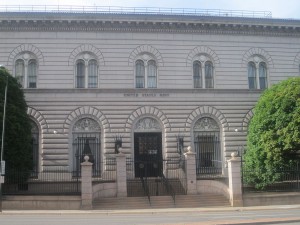
United States Branch Mint in Denver. In 2015, Denver produced over 8 billion coins, more than any other mint!
On January 11, 2016 the U.S. Government Accountability Office (GAO) release a report (GAO-16-177) about the “Implications of Changing Metal Compositions.” The GAO, an agency of the Legislative Branch, is supposed to be an independent, nonpartisan agency that investigates how the government spends taxpayer dollars and reports their findings to congress. It is important to remember that the GAO does not investigate for the sake of investigating agencies. They are asked by members of congress for a report about the implementation of specific policies. This report was requested by Rep. Bill Huizenga (R-MI), Chairman of the Subcommittee on Monetary Policy and Trade under the Finance Committee.
NON-NEWS FLASH: The U.S. Mint spends more money on the metals used to strike one- and five-cent coins than their face value.
“Wait,” you say. “That’s not news.” Of course you are right because you are an astute collector and a reader of the Coin Collectors Blog! Unfortunately, those who write news stories point to this GAO report to show that they are correct for proposing their narratives supporting changes to be made at the U.S. Mint. By focusing on the metals costs misses the entire story.
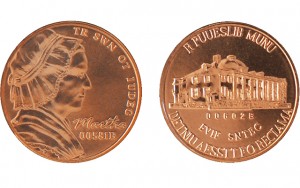
Experimental test strikes of the 5-cent denomination using Martha Washington/Mount Vernon nonsense dies were produced on planchets of the same copper-plated zinc composition used for the current Lincoln cents.
Changing coinage metals will not translate into instant savings. In fact, for the first two-to-three years it might show a loss greater than if congress would leave the metals composition the same. It is not clear whether the current die making and coining presses would work with a different planchets. And we are not talking about a few presses. Can you imagine how many presses were needed in Philadelphia and Denver to produce over 8 billion coins in each location in 2015?
If I remember correctly from my last visit to the Philadelphia Mint, there were 20 presses in one row of presses in Philadelphia. Four rows were used to strike one-cent coins in three 8 hour shifts. There were two rows striking five-cent coins. Change the composition of these coins and that means the U.S. Mint will have to make changes to 120 presses!
That only covers the physical changes to the presses. Since most of the alternative alloys are harder than the current cupronickel alloy, dies will have to be replaced more often, the presses will require additional maintenance, and the processing will have to change. There are annealing machines, upsetting mills, and internal transportation systems that would have to be changed for the new alloys.
I spoke with a friend who works for a major manufacturer with facilities all over the world. During the discussion I was reminded of the usual changes in manufacturing that causes interruptions but are significant to think about. For example, oil refineries can close for two-weeks to a month in order to be retooled in order to change the production of fuel blended for cold weather driving to those for warmer weather driving. These costs are built into the prices you pay at the gas pump.
Similarly, an automobile manufacturer that changes model designs have to close to retool and retrain employees on the new designs. Making simple changes are easy. Change a body style and the entire line has to close at a cost to manufacturing.
Retooling the Philadelphia and Denver mints will be like an automobile manufacturer changing the entire design of a model. The plant will be closed, new equipment will have to be installed and tested, and the employee trained. Planning, purchasing, and installing the equipment will require money to be spent. There will be more costs for training of everyone from the engravers that have to consider coining issues with the new metals to the die makers to the line workers.The other story missed is that the GAO claims that the coin-operated industry over estimated their estimation on the costs to the industry if change is changed. The GAO report cites a 2014 study provided to the U.S. Mint by the National Automatic Merchandising Association (NAMA), the $45 billion per year vending industry trade association in the United States, which says it will cost from $100 to $500 per machine to convert them to accept new coinage while the old coinage continues to circulate.
While trying to justify the over estimation claim, the GAO actually strengthens the NAMA argument by not controverting the per machine cost.
The GAO does not consider that the NAMA does not represent the entire coin-op industry. The American Amusement Machine Association (AAMA) represents coin-op games (video, pinball, etc.), fair operators, gum ball machine manufacturers, jukebox manufacturers, and similar businesses. When the report was first discussed, then AAMA President John Schultz was reported to have said to leave the coinage alone “because it works, rather than risk the costly consequences.” AAMA has not provided an estimate for those costly consequences.
Another consequence would be changes that the government would have to undergo to support new coinage alloys. Any location that the government relies on cash transactions would have to be updated accordingly. While the Postal Service has eliminated most of their vending machines in favor of automated kiosks, this change will hasten a complete removal of those vending machines that continue to operate in areas where electronically connected kiosks cannot be supported. This could leave people in remote communities without particular services they rely on.
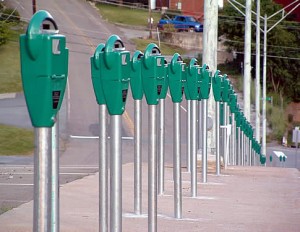
Aside from parking meters, how many vending machines, coin-op washers and dryers, change machines, even vending machines will have to be updated at your expense?
Someone my say to just eliminate the one-cent coin. Why not? Canada did it, why can’t the U.S. do the same? The most significant problem is that this would change an economy that is over 9-times the size of the Canadian economy. Using the Gross Domestic Product (GDP), the total cost of goods and services, as a benchmark converted to U.S. dollar, the World Bank reports that the GDP of $1.5183 trillion in 2010, the last year statistics are available. Similarly, the U.S. GDP in 2010 was $13.9631 trillion.
Even if someone was able to figure out how this change will impact an economy that produces over $15 trillion in goods and services (2014 data), there are also the ancillary costs of changing machines, systems, services, and anything else that could be impacted.
Although it might seem easy to change the alloys used for coins or eliminate the lowest denominations, the impact reaches far beyond all analysis including that of the GAO. To tell everyone to “just deal with it” is an expensive proposition that will have to be paid for. Are you ready to pay more taxes for governments to “just deal with it?” More fees for services? Or dealing with a loss of services because in order to “just deal with it” because the service provider decided that it is better to stop providing the service than convert?
- Image of Denver Mint courtesy of Wikipedia.
- Image of Martha Washington trial strikes courtesy of the U.S. Mint via Coin World.
- Image of the Philadelphia Mint was published in a Numismatic Bibliomania Society E-Sylum newsletter provided by Sandy Pearl.
- Parking meter image courtesy of Parkifi.


